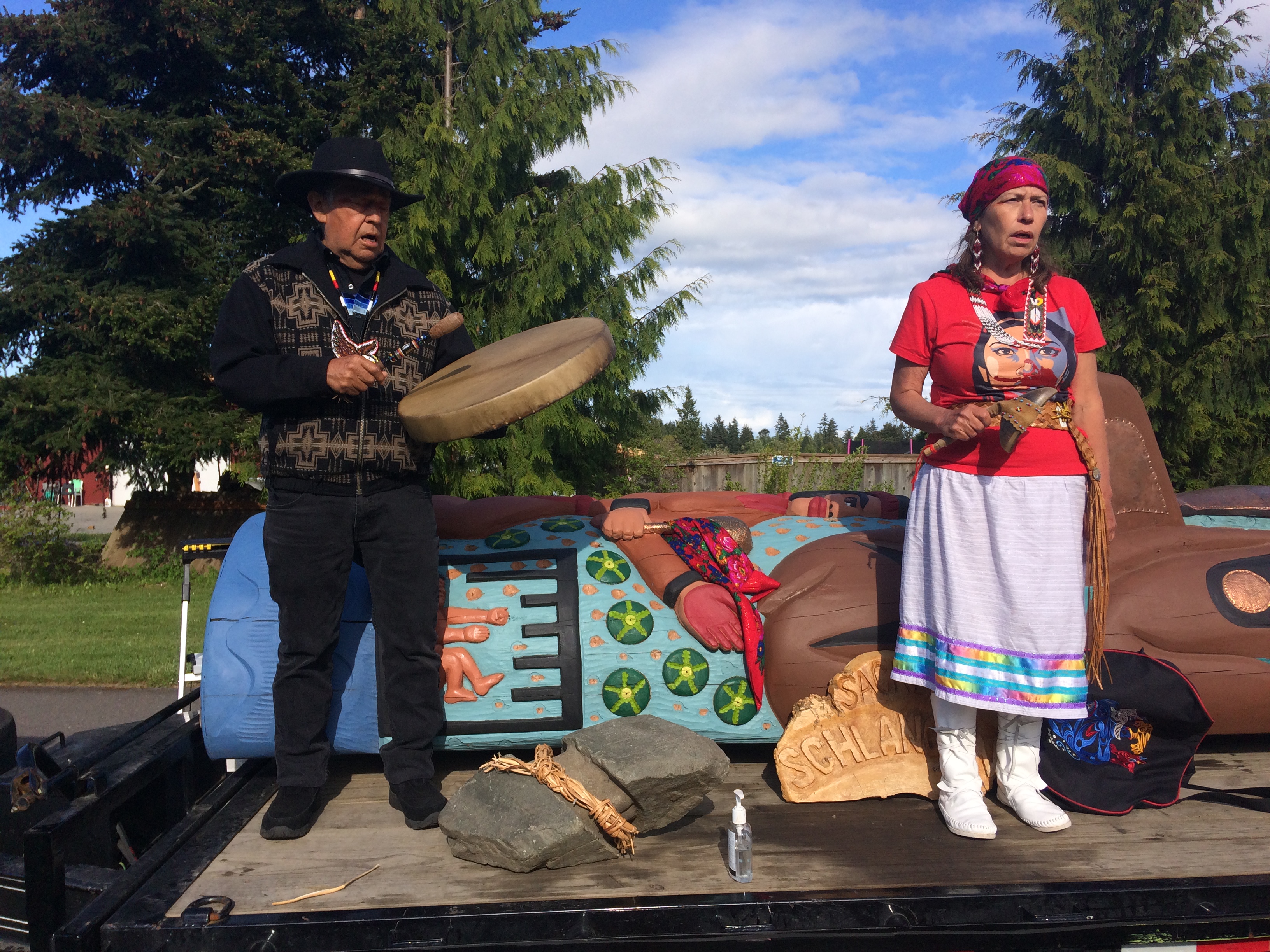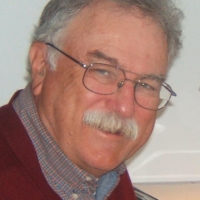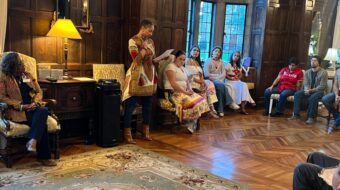
PORT ANGELES, Wash.—Woodcarvers from the Lummi Tribe brought their 24-foot cedar totem pole to the North Olympic Peninsula for a ceremony here, urging President Joe Biden and Congress to take stronger measures to protect sacred places, the rights of the people, and to save salmon and orca whales and planet Earth itself.
The totem’s message is focused on two menacing realities—the crisis of missing and murdered Native American women and the onslaught of human-created waste that threatens all life.
Members of the Lower Elwha Klallam Tribe greeted the arrival of the totem pole at City Pier on the Port Angeles waterfront on May 25. Drummers pounded a rhythmic beat and sang a Klallam song. Nearly 200 were in the crowd, including members of the Jamestown S’Klallams, Hoh, Quileute, and Makah Tribes, environmental activists, and supporters of Black Lives Matter and Voices for Health and Healing, a grassroots movement in support of the Jamestown S’Klallam tribe’s opioid ‘Healing Campus’ now under construction in Sequim.
Some of the environmentalists, members of North Olympic Orca Pod, were dressed in their orca whale costumes and holding signs demanding that four dams on the Snake River be breached to save the salmon and the orca pod in the Strait of Juan de Fuca that feed on the salmon.
Lower Elwha Klallam leader Mark Charles told the crowd that the tribe played a central role in the 20-year fight demanding the removal of two hydroelectric dams on the Elwha River. “I got a chance to work with the archeologists for the National Park Service,” he said, noting that several varieties of salmon have returned, swimming upriver to spawn since officials removed the dams in 2014.
“Now the tribe will be able to hunt and fish. It is one of the things we want. We’re taking the dams out for your generation. The best way to protect our treaty rights is to practice them.” Attached to the trailer under the totem was a banner, “Free the Snake River – Restore the Salmon.”
Lower Elwha Tribal Chairwoman Frances Charles led the crowd in a moment of silence in memory of lives lost, referring to the recent death of Kurt Grinnell, a beloved member of the Jamestown S’Klallam Tribal Council.

Hoh Tribal Elder Mary Kay Leitka told the crowd the totem carries a message to elected officials in Washington, D.C., that change is needed to protect the environment, human life, and human rights. Leitka, a master basket weaver living on the Hoh Reservation on the Pacific coast, told People’s World the totem is eloquent.
“You can see the images of children and grandmothers mourning the loss of their daughters,” she told the World. She said the precarious living conditions of Native Americans continue. Tribes living right on the shore of the Pacific, she said, are now forced to struggle to win clearance from the federal government to move their villages to higher grounds in case of a tsunami that would wipe out their homes.
At an earlier event at Olympic Unitarian Universalist Fellowship (OUUF), Doug James, one of the carvers, explained the symbolism of the totem pole. At the top is the image of a Native American man sitting before a fire “praying to the Great Creator to save mother earth for the children,” James said.
In the center of the flames is the image of a hand. Similar images of red hands are scattered on the white surface, symbolizing indigenous women who have disappeared. Lower on the totem is a diving eagle, reaching out with silver-painted salmon in his talons. “The eagle,” James explained, “sees the furthest, flies the fastest, sees up to heaven…. These Chinook salmon are dwindling down. Their spawning grounds are gone.”
Near the bottom of the totem pole, James continued, “is a Native American woman, a mother, her hand reaching out for her missing daughter.” And at the very bottom is a cage, a Native American inside, imprisoned by centuries of oppression, broken treaties, and now a plague of missing or murdered Indigenous women.
“It’s not too late, if we come together,” James added. He gestured toward the totem pole. “They are saying to us: ‘Look at what is happening to us here.’ This pole is saying come together with one heart and one mind.”
Native American activists, he continued, “went all around the country turning out the vote. They got enough votes in Indian Country to make a difference. So it was that victory that convinced us to start carving this totem pole with the intention of transporting it to Washington, D.C. It is a work in progress,” he concluded.
Among the victories that moved the woodcarvers was President Joe Biden’s naming Rep. Deb Haaland as the first Native American Secretary of the Interior.

James told People’s World that the Lummi Nation’s House of Tears wood carvers have been carving and carrying totem poles across the nation since his brother, master carver Jewell Praying Wolf James, carved a series of totem poles in memory of the victims of the terrorist attack on the World Trade Center towers in New York, Sept 11, 2001.
James’s wife, Siam’el wit, speaking to the outdoor ceremony at the OUUF hall, called on the crowd to unite against oppression. “We want the water to run clean without nuclear waste contamination. Industries are tearing up our sacred land,” she charged.
“Families, tribes, broken up, living in an assimilated way. They didn’t know how to live this way. We must come together as one people, pray together, work together. Save planet Earth…. We are fighting for all of our sisters to come home. Many women are gone, missing…exploited, raped, stolen from their families, forced into prostitution. We are praying for these missing women.”
Quantifying the scale of the crisis of missing and murdered Indigenous women is next to impossible because of notoriously faulty and incomplete data. A snapshot study by the Urban Indian Health Institute, for example, found that of the 5,712 cases it was able to document in the year 2016, authorities logged only 116 of them in the Department of Justice’s national database—a mere 2%.
Racial misclassification adds to the problem of unreliable statistics. A New York Times investigation found that Native women “are often misclassified as Hispanic or Asian or other racial categories on missing-persons forms,” thus potentially leaving thousands more out of federal databases and understating the magnitude of the crisis.
Taken together, the Urban Indian Health Institute says the problem is the result of “a deeply flawed institutional system rooted in colonial relationships that marginalize and disenfranchise people of color and remains complicit in violence targeting American Indian and Alaska Native women and girls.” Raising public awareness of the crisis remains a challenge, though, as more than 95% of cases never receive national or international news media coverage.
RELATED STORIES:










